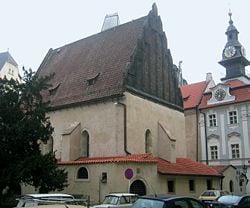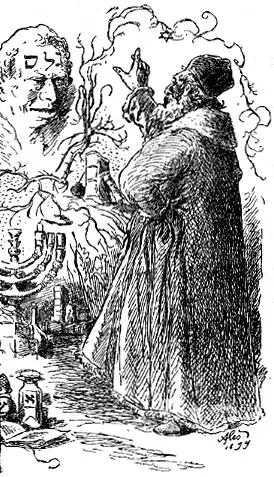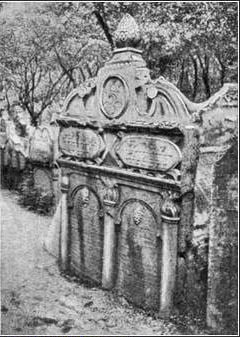Difference between revisions of "Judah Loew ben Bezalel" - New World Encyclopedia
m (→His name) |
m (→Influence) |
||
| Line 26: | Line 26: | ||
==Influence== | ==Influence== | ||
===Disciples=== | ===Disciples=== | ||
| − | + | Although he certainly had other pupils in Moravia, Judah 's main disciples from the Prague period include Rabbis [[Yom Tov Lipmann Heller]] and [[David Gans|David Ganz]]. The former promoted his teacher's program of regular [[Mishnah]] study by the masses, and composed his ''Tosefoth Yom Tov''—commentary incorporated into almost all modern editions of the Mishnah—with this goal in mind. David Ganz produced the ''Tzemach David'', a work of Jewish and general history, as well as writing on [[astronomy]]. | |
===Jewish philosophy=== | ===Jewish philosophy=== | ||
| − | + | The Maharal's works inspired the Polish branch of [[Hasidism]], as well as a more recent wave of [[Torah]] scholars originating from [[Lithuania]] and [[Latvia]], most markedly Rabbi [[Eliyahu Eliezer Dessler]] (1892-1953) and Rabbi [[Abraham Isaac Kook]] (1864-1935). A recent authority who had roots in both traditions was Rabbi [[Yitzchok Hutner|Isaac Hutner]] (1906-1980). Rabbi Hutner defined the [[ethos]] of the Maharal's teachings as being ''Nistar BeLashon Nigleh'', meaning: "The [[Kabbalah|Hidden]] in the [[language]] of the [[Talmud|Revealed]]." Hutner also maintained that Rabbi [[Samson Raphael Hirsch]] (1808-1888) must also have been influenced by the Maharal's ideas, basing his seemingly [[Rationalism|rationalistic]] [[World view|Weltanschauung]] on the more abstract and abstruse teachings of the hard-to-understand Kabbalah. | |
| − | + | The Maharal, however, was not a champion of the open study of [[Kabbalah]], and none of his works are in any way ''openly'' devoted to it. Nevertheless, Kabbalistic ideas permeate his writings in a rational and philosophic tone. His main Kabbalistic influences appear to have been the [[Zohar]] and [[Sefer Yetzirah]], as [[Isaac Luria|Lurianic Kabbalah]] had not by that time reached Europe. He was also entirely in favor of scientific research insofar as it did not contradict divine revelation. | |
| − | + | ===The Maharal and the golem=== | |
| + | The legend of the Maharal's creation of a [[golem]] inspired [[Gustav Meyrink]]'s 1915 novel ''[[The Golem (Meyrink)|Der Golem]]''. Various other books have been inspired by this legend, the authenticity of which has been doubted. Although the golem motif is old, the connection between the golem on the one hand and the Maharal on the other is known only from ca. 1840. | ||
| + | The Maharal is featured in the book ''[[He, She and It]]'' and the [[Dutch language|Dutch]] work ''De Procedure'' ("The Procedure," [[Harry Mulisch]], 1999), both retellings of the Golem legend. A poem by [[Jorge Luis Borges]], entitled ''[[El Golem]]'' also tells the story of Judah Loew and his giving birth to the Golem. | ||
| − | + | "The Maharal" by Yaakov Dovid Shulman (in English) questions if the stories ''about'' the golem are true. Even a [[Caldecott Medal]] winner (''[[Golem (book)|Golem]]'' by [[David Wisniewski]]) mentions Loew as Rabbi Loew. The fictional book [[Iron Council]] by [[China Miéville]] has a character named Judah Low who creates golems. | |
| − | + | As a mark of his devotion to the ways of the Maharal, Rabbi Hutner bestowed the name of the Maharal's key work the ''Gur Aryeh'' upon a branch of the yeshiva he headed when he established its [[kollel]] (a [[yeshiva]] for post-graduate Talmud scholars) which then became a division of the [[Yeshiva Rabbi Chaim Berlin]] in New York during the 1950s, known as [[Kollel Gur Aryeh]]. Both of these institutions, and the graduates they produce, continue to emphasize the serious teachings of the Maharal. | |
| − | |||
| − | |||
| − | |||
| − | |||
==Bibliography== | ==Bibliography== | ||
Revision as of 20:01, 7 August 2008
Judah Loew ben Bezalel, 1525-1609, was a major Talmudic scholar, Jewish mystic, and philosopher. He is widely known to scholars of Judaism as the Maharal of Prague, or simply as the Maharal (מהר"ל - a Hebrew acronym of Moreinu ha-Rav Loew, "Our Teacher the Rabbi Loew").
The Maharal famously associated with the story of the golem, a myth that first appeared in print close to 200 years after his death. He supposedly created the golem using magical powers based on the esoteric knowledge of how God created Adam, in order to defend the Jews of the Prague Ghetto from antisemitic attacks. In a more serious sense, he is known for his works on Jewish philosophy, Jewish mysticism, and his writing on Rashi's Torah commentary, known as Gur Aryeh al HaTorah.
Judah Loew ben Bezalel is buried at the Old Jewish Cemetery, Prague in Josefov, and his grave can still be visited.
Biography

The Maharal was probably born in Poznań in today's Poland, though his family seems to have originated from the German town of Worms. His birth year is uncertain, with different sources listing 1512, 1520, and 1526. His uncle Jacob was Reichsrabbiner ("Rabbi of the Empire") of the Holy Roman Empire, and his brotherm Chaim of Friedberg, was a well known rabbinical scholar. Traditionally it is believed that the Maharal's family descended from the Babylonian exilarchs and were therefore also from the Davidic dynasty. He received his formal education in various yeshivas (Talmudic schools).
Judah was independently wealthy, probably as a result of his father's successful business enterprises. He accepted a rabbinical position in 1553 as Landesrabbiner of Moravia at Mikulov (Nikolsburg). This position involved directing Jewish community affairs as well as determining the schedule of Talmud studies in the communities in that province. He also revised the Jewish community statutes on the election and taxation process. He retired from Moravia in 1588, probably at age 60, but these communities still considered him an authority long after his retirement.
While still in Moravia Judah fought against slanderous allegation of illegitimacy that were spread in the community against certain families and could ruin their ability to find a marriage partner for their children. This issue even affected his own family, and he used one of the two yearly grand sermons (between Rosh Hashanah and Yom Kippur 1583) to denounce the phenomenon.
Judah moved back to Prague in 1588, where he again accepted a rabbinical position, replacing the retired Isaac Hayoth. On February 23, 1592, he had an audience with Emperor Rudolf II. The conversation seems to have been related to the Kabbalah (Jewish mysticism) a subject which held much fascination for the emperor.
In 1592, the Maharal moved to Posen, where he had been elected as Chief Rabbi of Poland. There, he composed Netivoth Olam and part of Derech Chaim. Toward the end of his life he moved back to Prague, where he died in 1609. He is buried there, and his tomb still an attraction for tourists.
His name
| Rabbinical Eras |
|---|
The name "Löw" or "Loew," derived from the German Löwe, "lion." The Yiddish Leib is from the same origin. The name is related to the Hebrew Judah or Yehuda, who is traditionally associated with a lion. In the Book of Genesis, the patriarch Jacob refers to his son Judah as a Gur Aryeh, a "Young Lion" (Genesis 49:9) when blessing him. The Maharal's classic work on the Rashi commentary of the Pentateuch is called the Gur Aryeh al HaTorah, in Hebrew: "Young Lion [commenting] upon the Torah".
Influence
Disciples
Although he certainly had other pupils in Moravia, Judah 's main disciples from the Prague period include Rabbis Yom Tov Lipmann Heller and David Ganz. The former promoted his teacher's program of regular Mishnah study by the masses, and composed his Tosefoth Yom Tov—commentary incorporated into almost all modern editions of the Mishnah—with this goal in mind. David Ganz produced the Tzemach David, a work of Jewish and general history, as well as writing on astronomy.
Jewish philosophy
The Maharal's works inspired the Polish branch of Hasidism, as well as a more recent wave of Torah scholars originating from Lithuania and Latvia, most markedly Rabbi Eliyahu Eliezer Dessler (1892-1953) and Rabbi Abraham Isaac Kook (1864-1935). A recent authority who had roots in both traditions was Rabbi Isaac Hutner (1906-1980). Rabbi Hutner defined the ethos of the Maharal's teachings as being Nistar BeLashon Nigleh, meaning: "The Hidden in the language of the Revealed." Hutner also maintained that Rabbi Samson Raphael Hirsch (1808-1888) must also have been influenced by the Maharal's ideas, basing his seemingly rationalistic Weltanschauung on the more abstract and abstruse teachings of the hard-to-understand Kabbalah.
The Maharal, however, was not a champion of the open study of Kabbalah, and none of his works are in any way openly devoted to it. Nevertheless, Kabbalistic ideas permeate his writings in a rational and philosophic tone. His main Kabbalistic influences appear to have been the Zohar and Sefer Yetzirah, as Lurianic Kabbalah had not by that time reached Europe. He was also entirely in favor of scientific research insofar as it did not contradict divine revelation.
The Maharal and the golem
The legend of the Maharal's creation of a golem inspired Gustav Meyrink's 1915 novel Der Golem. Various other books have been inspired by this legend, the authenticity of which has been doubted. Although the golem motif is old, the connection between the golem on the one hand and the Maharal on the other is known only from ca. 1840. The Maharal is featured in the book He, She and It and the Dutch work De Procedure ("The Procedure," Harry Mulisch, 1999), both retellings of the Golem legend. A poem by Jorge Luis Borges, entitled El Golem also tells the story of Judah Loew and his giving birth to the Golem.
"The Maharal" by Yaakov Dovid Shulman (in English) questions if the stories about the golem are true. Even a Caldecott Medal winner (Golem by David Wisniewski) mentions Loew as Rabbi Loew. The fictional book Iron Council by China Miéville has a character named Judah Low who creates golems.
As a mark of his devotion to the ways of the Maharal, Rabbi Hutner bestowed the name of the Maharal's key work the Gur Aryeh upon a branch of the yeshiva he headed when he established its kollel (a yeshiva for post-graduate Talmud scholars) which then became a division of the Yeshiva Rabbi Chaim Berlin in New York during the 1950s, known as Kollel Gur Aryeh. Both of these institutions, and the graduates they produce, continue to emphasize the serious teachings of the Maharal.
Bibliography
- Gur Aryeh ("Young Lion," see above), a supercommentary on Rashi's Pentateuch commentary
- Netivoth Olam ("Pathways of the World"), a work of ethics
- Tif'ereth Yisrael ("The Glory of Israel"), philosophical exposition on the Torah, intended for the holiday of Shavuot
- Gevuroth Hashem ("God's Might[y Acts]"), for the holiday of Passover
- Netzach Yisrael ("The Eternity of Israel"; Netzach "eternity," has the same root as the word for victory), on Tisha B'Av (an annual day of mourning about the destruction of the Temples and the Jewish exile) and the final deliverance
- Ner Mitzvah ("The Candle of the Commandment"), on Hanukkah
- Or Chadash ("A New Light"), on Purim
- Derech Chaim ("Way of Life"), a commentary on the Mishnah tractate Avoth
- Be'er ha-Golah ("The Well of the Diaspora"), an apologetic work on the Talmud, mainly responding to interpretations by the Italian scholar Azariah di Rossi (min ha-Adumim)
- Chiddushei Aggadot ("Novellae on the Aggada," the narrative portions of the Talmud), discovered in the 20th century
- Derashot (collected "Sermons")
- Divrei Negidim ("Words of Rectors"), a commentary on the Seder of Pesach, published by a descendant
- Various other works, such as his responsa and works on the Jewish Sabbath and the holidays of Sukkot, Rosh Hashana and Yom Kippur, have not been preserved.
His works on the holidays bear titles that were inspired by the Biblical verse in I Chronicles 29:11: "Yours, O Lord, are the greatness, and the might, and the glory, and the victory, and the majesty, for all that is in the heavens and on the earth [is Yours]; Yours is the kingdom and [You are He] Who is exalted over everything as the Leader." The book of "greatness" (gedula) on the Sabbath was not preserved, but the book of "power" (gevurah) is Gevurath Hashem, the book of glory is Tif'ereth Yisrael, and the book of "eternity" or "victory" (netzach) is Netzach Yisrael.
See also
- André Neher
- Kerem Maharal, a moshav in northern Israel name in his honor
ReferencesISBN links support NWE through referral fees
- Byron L. Sherwin, Mystical Theology and Social Dissent: The Life and Works of Judah Loew of Prague (Fairleigh Dickinson University Press, 1982)
- Rivka Schatz, “Maharal’s Conception of Law- Antithesis to Natural Law” Jewish Law Annual Vol. VI.
- Rivka Schatz, “Existence and Eschatology in the Teachings of the Maharal” Immanuel 14 (Spring 1982) 66-97; Immanuel 15 (Winter 1982-3) 62-72.
- Moshe Zuriel "Numbers: Their meaning and Symbolism According to Maharal" [Hebrew] HaMaayan 18:3 (1978) 14-23; 18:4 (1978) 30-41, reprinted in Sefer Ozrot Gedolei Yisroel (Jerusalem:2000) volume 1, pp. 204-228.
- Martin Buber, "The Beginning of the National Idea" On Zion: The History of an Idea. (New York, Schocken Books, 1973).
- Otto Dov Kulka, "The Historical Background of the National and Educational Teachings of the Maharal of Prague" [Hebrew] Zion 50 (1985) 277-320.
- Benjamin Gross, Netzah Yisrael (Tel Aviv: Devir, 1974)
- Mordechai Breuer, “The Maharal of Prague’s Disputation with Christians: A Reappraisal of Be’er Ha-Golah” in Tarbiz (1986) 253-260
- Adlerstein Y. Be'er Hagolah: The Classic Defense of Rabbinic Judaism Through the Profundity of the Aggadah. New York, NY: Mesorah Publications, 2000. ISBN 1-57819-463-6.
- Aharon Kleinberger, The Educational Theory of the Maharal of Prague [Hebrew] (Magnes: 1962).
- Andre Neher, Jewish Thought and the Scientific Revolution: David Gans (1541-1613) and his times (Oxford-New York: Littman Library, 1986)
- Neher, Faust et le Maharal de Prague: le Mythe et le Reel (Paris: Presses Universitaires de France, 1987);
- Neher, Le Puits de l'Exil: la Theologie Dialectique du Maharal de Prague (Paris: A. Michel, 1996)
- Neher, Mishnato shel ha-Maharal mi-Prague, Reʾuven Mass,c2003.
- Gross, Benjamin, Yehi Or (Reʾuven Mass, 1995).
- Gross, Benjamin, Netsah Yiśraʾel Tel Aviv : Devir, 1974.
Notes
External links
Articles
- Short biography of The Maharal of Prague chabad.org
- Rabbi Judah Loew, The Maharal of Prague ou.org
- Yehuda Loew — The Maharal jewishvirtuallibrary.org
- The Maharal, Rabbi Yehuda Loew of Prague, e-wellsprings.org
- Family tree
- The Seder Plate of the Maharal from The Maharal Haggadah by Shlomo Mallin
Resources
- Tiferet Yisrael,Hebrew Full-text
- Gevurot HaShem,Hebrew Full-text
- Ner Mitzvah, Hebrew Full-text
- Netzach Israel Chapters 11-13, Hebrew Full-text
- Derech Chaim (Discussion):
- [1] and
- [2]
Credits
New World Encyclopedia writers and editors rewrote and completed the Wikipedia article in accordance with New World Encyclopedia standards. This article abides by terms of the Creative Commons CC-by-sa 3.0 License (CC-by-sa), which may be used and disseminated with proper attribution. Credit is due under the terms of this license that can reference both the New World Encyclopedia contributors and the selfless volunteer contributors of the Wikimedia Foundation. To cite this article click here for a list of acceptable citing formats.The history of earlier contributions by wikipedians is accessible to researchers here:
The history of this article since it was imported to New World Encyclopedia:
Note: Some restrictions may apply to use of individual images which are separately licensed.

